We are racing along the coast road, passing banana plantations, goat herders, little bars, and whitewashed houses. To our right the ocean crashes against the black, rocky shore. The waves – huge and rolling – are the pale ice blue of a glacier. Yesterday we trekked through a prehistoric forest; tomorrow we will climb a volcano.
This place feels exotic and strange. I had always thought of Tenerife as a beach destination: bland chain hotels squatting on black sand. Two for one cocktails. Pizza and chips.
I didn’t have a clue. The island, the largest of the Canaries, arches out of the sea, split by a spine of volcanic mountains. The symbol of Tenerife is the dragon tree, and the island itself is like a dragon – full of fire and dotted with volcanoes, the largest of which is El Teide, a massive 3,718 metres high. South of it are the resorts used by holidaying Brits. The landscape there is desert, all sandy rock and bleached-out cacti. But cross to the north of the island and a secret world is revealed. This is where the Spanish colonised Tenerife in the 15th century, building pretty towns, and taking advantage of the more temperate climate to grow food and make excellent wine. And it’s remarkably still under the tourist radar. Of the 1.5 million Brits who visited Tenerife between January and September 2016, only around 75,000 stayed in the north.

For winter sun, Tenerife does offer genuine warmth. It’s November when we visit and still hot enough for the beach most days. That doesn’t mean it never rains. A planned five-hour hike through Anaga country park, an ancient cloud forest of rare ferns and laurels, was curtailed by an unusually monsoon-like downpour.
We take refuge in a simple beachside restaurant, Estrella del Mar in the capital, Santa Cruz. It was the equivalent of a greasy spoon, except here the greasy spoons do freshly grilled seafood and good wine. A steaming bowl of Tenerife’s famous wrinkly potatoes, cooked in salt until they’re shrivelled and crispy, go down a treat dipped in mojo, the Canary Islands’ signature piquant salsa.
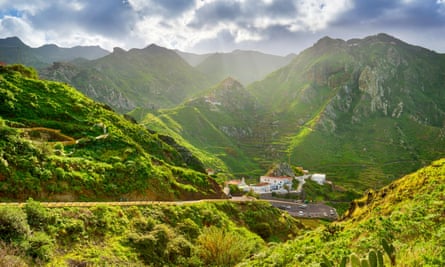
We head back to our hotel, the San Roque, a traditional house with rooms around a central courtyard in Garachico, stopping off in Puerto de la Cruz to wander along the shore. As the sun begins to set, surfers are catching the last waves, while on the harbour old men are roasting chestnuts and drinking young red wine. At the hotel, guests are eating by the pool: it’s still warm enough to stay outside drinking and chatting well into the evening.
Garachico was the island’s main port until a volcanic eruption in 1706 destroyed the harbour. We wander out to enjoy vermouths in the square by the old bandstand, followed by fresh fish and plenty of red wine at La Perla. It’s the sort of restaurant I dream of finding on holiday – brightly lit, with vinyl floors, ridiculously fair prices and friendly hosts, Jesus and Ana.
The next day we take a blockbuster tour of the best things Tenerife has to offer beginning in the university city of San Cristóbal de la Laguna, with its colourful 16th-century buildings. The sun is warming the streets, and families throng outside cafes, catching up over churros and hot chocolate. The best churros are found at Miguel Angel on Plaza del Cristo – a down-to-earth cafe run by a man with swept-back, greasy white hair and a medallion. A bag of 10, dusted in sugar and hot from the frier, are crunchy on the outside and light as a cloud within.
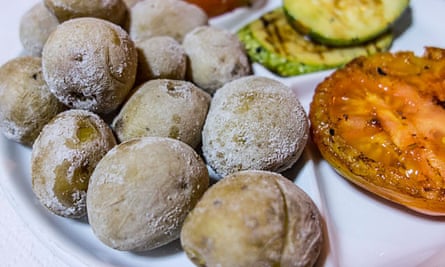
But we can’t linger: there’s more drinking to be done. We head to the wine museum for a tasting, noting how odd it is that we never get Tenerife wine back home. But of course – the island’s vineyards can only produce so much, and most of it is drunk by the Spanish. At Bodegas Monje vineyard , we learn how to make those wrinkly potatoes and mojo, before eating them with slow-cooked black pig in red wine.
Our next stop is the volcano. The atmosphere alters rapidly as the road curves up through eucalyptus trees then pines shrouded in mist. Small bands of people loom out of the haze, foraging for mushrooms. We emerge on to a windswept summit and another strange sight: bulbous white towers, whipped by clouds that scud at ground level. This is the Teide Observatory, where scientists study zodiacal light and solar activity with vast telescopes. Tenerife’s clear, dark skies make it one of the best places to study the solar system, and in June the island hosts Starmus, a stargazing festival with music, planets and Stephen Hawking. We tour the telescopes, and take turns to look through one at the sun itself, dark red through the filter, with sun spots and solar flares. It’s an oddly intimate moment.
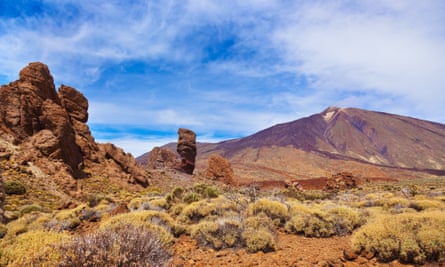
From the observatory, we look out across the great crater of Teide national park, a wild, barren, almost Martian landscape. Or is it Utah? Rock formations rising like totem poles in the distance are hardened lava from the funnels of dead volcanoes, long since eroded by the wind.
As the sun drops, we try to stay warm. Up here the temperature drops below freezing on winter nights. Snow will start to fall soon, transforming the Martian landscape into an Arctic one. That evening we meet with a star guide and crane our heads to look at the night sky, enjoying the sound of the words: Perseid, Pleiades, Andromeda, Vega.
The next day back down on the coast it’s hot and sunny enough for a bit of sunbathing before we head home – feeling like we’ve been to five countries in four days.




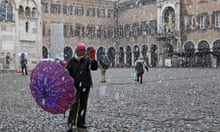


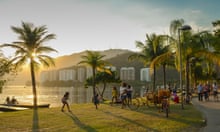
Comments (…)
Sign in or create your Guardian account to join the discussion